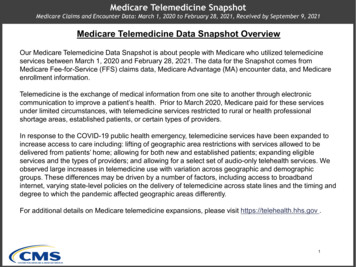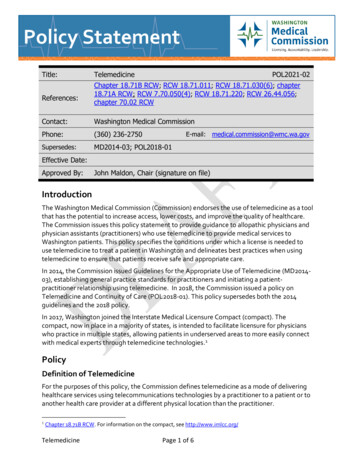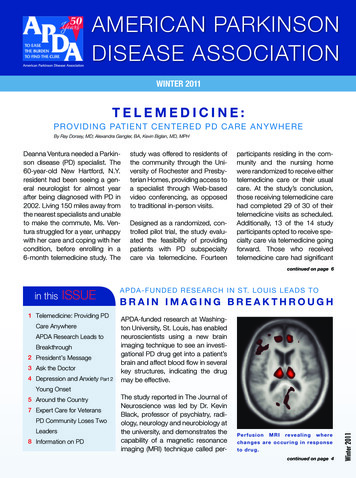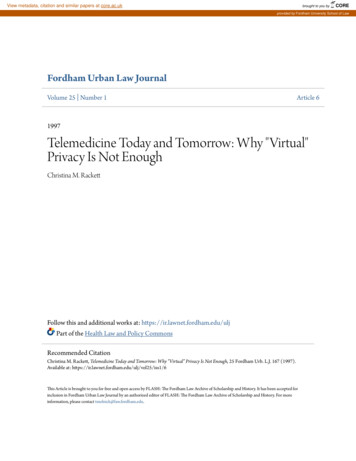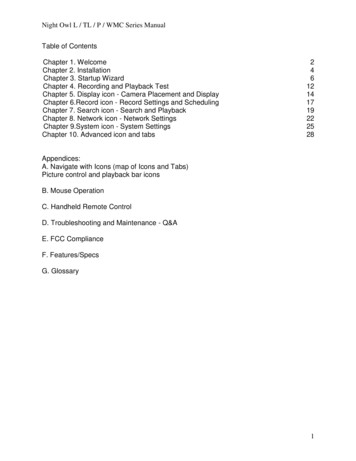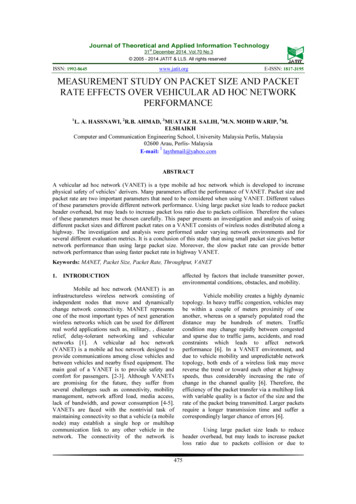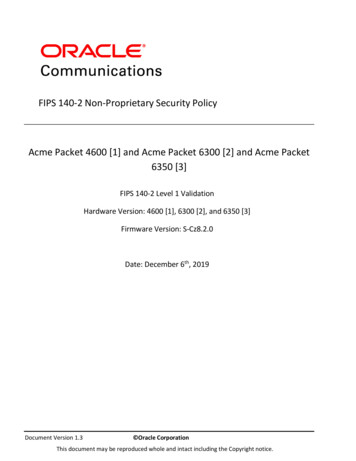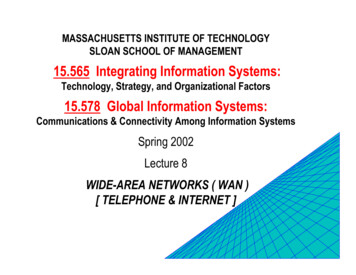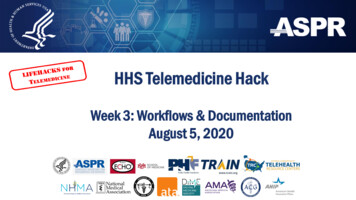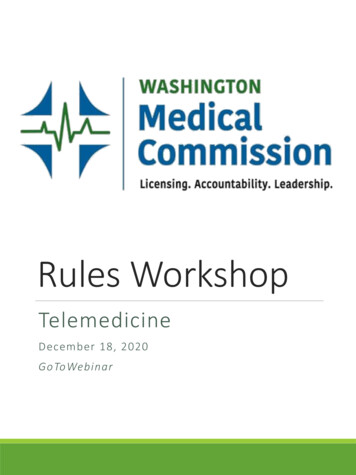
Transcription
Rules WorkshopTelemedicineDecember 18, 2020GoToWebinar
Table of ContentsPageMeeting Notice . 3Agenda . 5CR-101 . 7Telemedicine Definition Discussion . 9Comments . 12OCHIN . 13Albert Wertz, DO . 15Proposed Language . 18
Rule Workshop NoticeMeeting AnnouncementFor the Washington Medical Commission*CR-101 for Telemedicine RulesWAC 246-919-XXX PhysiciansWAC 246-918-XXX Physician AssistantsRulemakingThe Washington Medical Commission (commission) has officially filed a CR-101with the Office of the Code Reviser on September 17, 2019. The WSR# is 19-19072.The commission is considering rulemaking to address the practice of physiciansand physician assistants engaging in telemedicine with Washington patients.Possible subjects the commission may address are: what, if any requirements forlicensure; record keeping requirements; establishing a patient-practitionerrelationship; prescribing issues; and standard of care. Regulating the use oftelemedicine would place the commission in an active patient safety role.Proposed Telemedicine Rules Workshop MeetingIn response to the filing, the Commission will conduct an open public rulesworkshop on Friday, December 18, beginning at 3:00 pm via GoToWebinar.Please register for Telemedicine Rules Workshop on Dec 18, 2020 3:00 PM PST 84114325478155After registering, you will receive a confirmation email containing informationabout joining the webinar.This meeting will be open to the public.In response to the COVID-19 public health emergency, and to promote socialdistancing, the Medical Commission will not provide a physical location for thismeeting. A virtual public meeting, without a physical meeting space, will be heldinstead.
The purpose of the rules workshop will be to: Discuss the definition of “Telemedicine” Discuss some stakeholder/public commentsInterested parties, stakeholders, and the general public are invited to participatein the rules workshops or provide comments on draft rules. For continuedupdates on rule development, interested parties are encouraged to join theCommission’s rules GovDelivery.For more information, please contact Amelia Boyd, Program Manager,Washington Medical Commission at (360) 236-2727 or by email d draft language*CR means Code Reviser
Rules Workshop AgendaIn response to the COVID-19 public health emergency, and to promote social distancing, the MedicalCommission will not provide a physical location for this meeting. A virtual public meeting, without a physicalmeeting space, will be held instead. The registration link can be found below.Friday, December 18, 2020 – 3:00 pm to 5:00 pmTelemedicine Pre-Proposal Rules HousekeepingOpen workshopDiscuss definition of “Telemedicine”Address comments:o OCHINo Albert Wertz, DO Next steps Close workshopPlease register for Telemedicine Rules Workshop on Dec 18, 2020 3:00 PM PST 84114325478155After registering, you will receive a confirmation email containing information aboutjoining the webinar.The most recent draft language is available in the workshop packet but, will not bediscussed at this workshop. If you have comments about the draft, please send them tomedical.rules@wmc.wa.gov.To request this document in another format, call 1-800-525-0127. Deaf or hard of hearing customers, please call 711 (Washington Relay) oremail civil.rights@doh.wa.gov.PO Box 47866 Olympia, Washington 98504-7866 Medical.Commission@wmc.wa.gov WMC.wa.gov
CR-101
-19-072.htmWSR 19-19-072PREPROPOSAL STATEMENT OF INQUIRYDEPARTMENT OF HEALTH(Medical Quality Assurance Commission)[Filed September 17, 2019, 10:06 a.m.]Subject of Possible Rule Making: WAC 246-919-XXX Allopathic physicians and 246-918-XXXAllopathic physician assistants, the Washington medical commission (commission) is considering creating newrule sections to regulate the use of telemedicine.Statutes Authorizing the Agency to Adopt Rules on this Subject: RCW 18.71.017, 18.130.050, and18.71A.020.Reasons Why Rules on this Subject may be Needed and What They Might Accomplish: The commissionwill consider rule making to address the practice of physicians and physician assistants engaging in telemedicinewith Washington patients. Possible subjects the commission may address are: What, if any requirements forlicensure; recordkeeping requirements; establishing a patient-practitioner relationship; prescribing issues; andstandard of care. Regulating the use of telemedicine would place the commission in an active patient safety role.Other Federal and State Agencies that Regulate this Subject and the Process Coordinating the Rule withThese Agencies: None.Process for Developing New Rule: Collaborative rule making.Interested parties can participate in the decision to adopt the new rule and formulation of the proposedrule before publication by contacting Amelia Boyd, Program Manager, P.O. Box 47866, Olympia, WA 985047866, phone 360-236-2727, TTY 360-833-6388 or 711, email amelia.boyd@wmc.wa.gov, web sitewmc.wa.gov.Additional comments: To join the interested parties email list, please /subscriber/new?topic id WADOH 153.September 13, 2019Melanie de LeonExecutive 19-072.htm1/1
TelemedicineDefinition Discussion
December 18, 2020 Telemedicine Rules WorkshopTelemedicine Definition DiscussionConsider:a) Should it exclude phone calls? The parity statute and the HCA rule both exclude phonecalls, etc., as do many states.b) Should it include store and forward?c) Should it include remote monitoring?d) Should it include teleradiology and telepathology?Comments98point6The Appropriate Use of Telemedicine Guideline, issued on October 3, 2014, states theCommission “[r]ecogniz[es] that technology changes are developed and become applied topractice with dazzling speed, and the intent is to delineate general principles applicable both toexisting and future technologies, rather than focusing on specific current technologies.”98point6 recommends any rules adopted continue to remain neutral to the types of technologyleveraged to facilitate care, in accordance to the 2014 Guideline.98point6 delivers care by leveraging innovative technologies not contemplated when many ofthe rules and regulations governing telemedicine services were first promulgated throughoutthe United States. We encourage any forthcoming rule to focus on the principles that supportbalancing the quality of care and continuity of care provided via telemedicine, rather thanconcentrate on a prescriptive approach to the technologies that may be utilized. A prescriptivestatement regarding the technologies that may be leveraged or a narrow focus on howtechnologies must be used may inadvertently stifle the development of innovative techniquesand emerging technologies that could ultimately vastly improve the quality, affordability andaccessibility of care for patients in Washington state. Indeed, the definition as proposed fails toaddress 98point6’s primary methodology of delivering care, which is text-based interactionsbetween our patients, our software and our physicians within our secure mobile application.Telemedicine definition - 98point6’s suggested replacement textThe practice of medicine and delivery of health care services through the use of interactiveaudio and video technology, permitting real-time communication between the patient at theoriginating site and the provider, for the purpose of diagnosis, consultation, or treatment.Telemedicine does not include the use of audio-only, telephone, facsimile, or email.OCHINWe encourage the Commission to modify the definition of “telemedicine” to includeasynchronous store and forward technologies. Allowing the utilization of asynchronous
technologies will ensure patients receive essential medical services, particularly specialty care,that underserved patient populations would not otherwise have the ability to access. It alsoenhances care coordination and increases efficiencies of practitioners to the benefit of patientcare and the healthcare system. This modified definition would ensure continued access toelectronic consult (eConsult) services utilized by OCHIN members as well as other peer-to-peerconsultations addressed in the draft rules.Vision Care InnovationTelemedicine: The practice of medicine and delivery of health care services through the use ofstore and forward technology or interactive audio and video technology, permitting real-timecommunication interaction between the patient at the originating site and the provider, for thepurpose of diagnosis, consultation, or treatment. Telemedicine does not include the use ofaudio-only, telephone, facsimile, or email.American Telemedicine AssociationTelemedicine: A mode of delivering healthcare services through the use of telecommunicationstechnologies, including but not limited to asynchronous and synchronous technology, andremote patient monitoring technology, by a healthcare practitioner to a patient or apractitioner at a different physical location than the healthcare practitioner.Hims & HersTelemedicine: A mode of delivering healthcare services through the use of telecommunicationstechnologies, including but not limited to asynchronous and synchronous technology by ahealthcare practitioner to a patient or a practitioner at a different physical location than thehealthcare practitioner.Teladoc Health“Telemedicine” means a mode of delivering health care services through the use oftelecommunications technologies by a health care practitioner to a patient at a differentphysical location than the health care practitioner.TechNetProposed definition of telemedicine by the Commission:“ through the use of interactive audio and video technology, permitting real-timecommunication between the patient at the originating site and the provider, for the purpose ofdiagnosis, consultation, or treatment. Telemedicine does not include the use of audio-only,telephone, facsimile, or email.”This definition is outdated, fails to reflect the recent experience with telemedicine across thecountry during the COVID-19 pandemic and neither reflects nor encourages technologicalinnovations in remote patient care.Suggested language:Telemedicine: means a mode of delivering health care services through the use oftelecommunications technologies, including but not limited to direct and real-time
communication and store and forward technology, by a health care practitioner to a patient ata different physical location than the health care practitioner.Zoom Care/The Holt CompanyTelemedicine definition: We believe telemedicine rules should be modality agnostic, and therules should allow both synchronous and asynchronous means. The draft definition is toolimited in this regard.
Comments
Transmittal via electronic mailNovember 20, 2020Washington Medical CommissionPost Office box 47866Olympia, WA 98504Dear Members of the Washington Medical Commission:On behalf of OCHIN, we appreciate your rule-making to prioritize telehealth and virtual services topreserve access for patients in community health clinics. OCHIN is a Portland, Oregon based 501(c)(3)not-for-profit community-based health information technology and research network, and a nationalleader in promoting high-quality health care in historically underserved communities across the country.We have two decades of experience transforming health care delivery. We provide leading-edgetechnology, data analytics, research, and support services to more than 500 health care organizationsserving nearly 6 million patients. In Washington state, OCHIN serves several members, including KingCounty Public Health Department, King County Department of Corrections, Bastyr Center for NaturalHealth, Country Doctor Community Health Centers, NeighborCare Health, and Asian Counseling andReferral Services. Additionally, we are in discussions with potential Indigenous community partners. Weare writing to comment on the draft rule definitions related to telemedicine.RECOMMEND: MODIFICAITON OF DEFINITION OF PRACTICE OF MEDICINEWe encourage the Commission to modify the proposed definition of “practice of medicine.” Werecommend striking the reference to payment. The draft definition interjects payment policy with theregulation of medical practice. The definition provides that practitioners must have an expectation ofpayment in order to practice medicine using telemedicine. Unfortunately, this would prevent safety-netclinics in the OCHIN network as well as other providers of underserved communities from usingtelemedicine. Safety-net clinics provide uncompensated care to a segment of patients who may not beable to pay the practitioner and may not have health insurance coverage. Nevertheless, they should stillbe able to obtain access to evaluation, diagnosis, or treatment through telemedicine technologies thatare available to them. We recommend eliminating the reference to an “expectation of compensation”from the definition of the practice of medicine.RECOMMEND: MODIFICATION OF DEFINITION OF TELEMEDICINEWe encourage the Commission to modify the definition of “telemedicine” to include asynchronous storeand forward technologies. Allowing the utilization of asynchronous technologies will ensure patientsreceive essential medical services, particularly specialty care, that underserved patient populationswould not otherwise have the ability to access. It also enhances care coordination and increasesefficiencies of practitioners to the benefit of patient care and the healthcare system. This modifieddefinition would ensure continued access to electronic consult (eConsult) services utilized by OCHINmembers as well as other peer-to-peer consultations addressed in the draft rules.
RECOMMEND: REMOVE RESTRICTIONS ON AUDIO-ONLY TECHNOLOGIESFinally, we strongly encourage the Commission to remove restrictions in the draft rules that disallowaudio-only technologies from consideration as telemedicine. Audio-only modalities should not beexcluded as for some patients this is the only way a patient is able to access practitioner. This isparticularly the case for elderly patients. Among the patients OCHIN collaborative members see, thepatient might not receive care if this is disallowed. This definition simply does not reflect what we havelearned about telemedicine through the experience of the coronavirus public health emergency,particularly with people in the state who lack access to broadband or devices to take advantage oftechnology.Thank you for the opportunity to comment. We welcome the opportunity to discuss these items withmembers of the Commission or staff if that is helpful.Sincerely,Jennifer StollExecutive Vice PresidentGovernment Affairs and Public Relations2
Boyd, Amelia (WMC)From:Sent:To:Subject:Albert Wertz albertwertz@gmail.com Friday, October 9, 2020 2:22 PMBoyd, Amelia (WMC)conference today on telepsych rule makingFollow Up Flag:Flag Status:Follow upFlaggedAmelia, I am a psychiatrist and I work virtually for both corporations and my own private practice.In reading the packet I am very pleased with a majority of the wording written in the first draft.Its very important that we allow patients to establish care with live face to face video options and not just in person.We need to prevent prescribing based on surveys, which unfortunately is already taking place in offices due to medicarespecifically paying for the PHQ9,We must be inclusive of options for independent physician practices and not limiting of technology that requiresproviders to join large corporate conglomerates. let's preserve and promote independent practice. This increasescompetition and drives costs to patients down.In review of the packet, I agree with language in sections A, B with one question. Why are we allowing peer to peerteleconsults without a state license? How do you expect to hold the provider accountable and take a proactive approachto patient safety if you dont require the provider to have a state license first? My fear is this is a slippery slope toreactive discipline and not proactive safety. I do not believe section C is enforceable without mandating state licensurebefore providing care. I can understand this being needed in an emergency, or a state of emergency, but not as a basicstandard practice. unless they are of a specialty of critical need?I agree with the wording of section 1section 2 is questionable, this is saying you cant see a patient unless they provide written consent first, but if you areestablishing care in the live video meeting, is verbal consent ok? is verbal consent at the beginning of theappointment ok? is written consent in email from a patient not implied by just accepting the appointment andseeking care?There are several medical situations where evaluations without consent are very important. for example, delirium,Altered mental status, violent psychosis, danger to self or others. In these settings a psychiatrist may need to do achart review, lay eyes on a patient and evaluate without consent. Currently in Texas, this is a barrier. I do not believeit should be a barrier in our state in the setting of situations of public safety, psychosis, delirium, or medicalemergency.Otherwise I agree with sections 3‐6. All wording appears to allow providers to still operate with little investment neededto see patients. I just wanted to make sure we were not going to force providers to join tech conglomerates just toprovide patient care.thanks for your time, and allowing me to participate in that conference. Psychiatry is very different from most otherfields of medicine in that a majority of it can be performed through live video feed. but also, so much can be done peerto peer over the phone. Even UW medicine offers 24/7 phone consultation.‐‐1
Albert Wertz, DOC 210‐986‐4740F kvirtualpsychiatry.comTo help protect y our priv acy ,Micro so ft Office prev entedauto matic downlo ad o f thispicture from the Internet.2
Proposed LanguageThis language will not be discussed at this workshop.If you have comments about the draft, please sendthem to medical.rules@wmc.wa.gov.
Washington Medical CommissionDraft Language for chapter 246-919 WAC – PhysiciansTelemedicineWAC 246-919-650Purpose and Scope. The purpose of thisrule is to establish consistent standards for physicians who usetelemedicine to evaluate, diagnose, monitor or treat patients inWashington. The commission distinguishes between telemedicine,which is focused on the clinical aspects of care, andtelehealth, a broader term that encompasses clinical care plushealth-related education, public health and healthadministration. This rule does not apply to digital health whichinvolves digital, mobile, wearable technologies that facilitatethe tracking and monitoring of health status and behavioroutside the clinical encounter.WAC 246-919-651Definitions. The definitions in thissection apply throughout this chapter unless the context clearlyrequires otherwise.
(1) “Artificial or assistive intelligence” (AI) means theuse of complex algorithms and software to emulate humancognition in the analysis of complicated medical data.Specifically, AI computer algorithms that approximateconclusions without direct human input. Because AI can identifymeaningful relationships in raw data, it can be used to supportdiagnosing, treating and predicting outcomes in many medicalsituations.(2) “In-person encounter” means that the physician and thepatient are in the physical presence of each other and are inthe same physical location during the physician-patientencounter.(3) “Interpretive services” means reading and analyzingimages, tracings, or specimens through telemedicine or givinginterpretations based on visual, auditory, thermal, ultrasonicpatterns or other patterns as may evolve with technology.(4) “Practice of medicine” has the same meaning as in RCW18.71.011. The practice of medicine takes place at the location
of the patient. A physician using a web portal to engage in theactivity listed in RCW 18.71.011 with a patient located inWashington is considered to be practicing medicine inWashington.(5) “Remote monitoring” means the use of digitaltechnologies to collect health data from a patient in onelocation and electronically transmit that information securelyto a health care provider in another location for evaluation andinforming treatment decisions.(6) “Store-and-forward technology” means the use of anasynchronous or non-simultaneous transmission of a patient'smedical information from an originating site to the health careprovider at a distant site that results in medical diagnosis andmanagement of the patient, and does not include the use ofaudio-only telephone, facsimile, or email.(7) “Telemedicine” means the delivery of healthcareservices through the use of telecommunications technology by ahealth care provider in one location and a patient in another
location. Telemedicine includes real-time interactive services,store-and-forward technologies, interpretive services, andremote monitoring. For the purposes of this rule, telemedicinedoes not include providing medical services only through anaudio-only telephone, email messages, facsimile transmissions,or U.S. mail or other parcel service, or any combinationthereof. These types of communications with patients are notprohibited, but do not fall within the requirements of thisrule.WAC 246-919-652License required. Exemptions.(1) Except as provided in (2) of this subsection, aphysician using telemedicine to diagnose or treat a patient inWashington must hold an active license to practice as aphysician and surgeon in Washington.(2) Exemption for established patient.A physician notlicensed in Washington may use telemedicine to provide medicalcare to a patient in Washington if the following conditions aremet:
(a) The physician holds an active license to practicemedicine in another state or United States territory;(b) The physician has an established physician-patientrelationship with the patient and provides follow-up care totreatment previously provided when the patient was located in astate or United States territory where the physician is holds anactive license; and(c) The physician does not set up an office or place ofmeeting patients in Washington.(3) Exemption for peer-to-peer consultation. A physiciannot licensed in Washington may consult with a health careprovider licensed in Washington to provide medical care to aWashington patient if the following conditions are met:(a) The physician holds an active license to practicemedicine in another state or United States territory;(b) The Washington-licensed health care provider remainsprofessionally responsible for the primary diagnosis and anytesting or treatment provided to the Washington patient; and
(c) The non-Washington-licensed physician does not set upan office or place of meeting patients, physical or virtual, inWashington.WAC 246-919-653Standard of care. The commission will holda physician who uses telemedicine to the same standards of careand professional ethics as a physician using a traditional inperson encounter with a patient. Failure to conform to theappropriate standards of care or professional ethics while usingtelemedicine may be a violation of the laws and rules governingthe practice of medicine and may subject the licensee todiscipline by the commission.WAC 246-919-654Scope of practice. A physician who usestelemedicine shall ensure that the services provided areconsistent with the physician’s scope of practice, including thephysician’s education, training, experience, and ability.WAC 246-919-655Identification of patient and physician. Aphysician who uses telemedicine shall verify the identity of thepatient and ensure that the patient has the ability to verify
the identity, licensure status, and credentials of all healthcare providers who provide telemedicine services prior to theprovision of care.WAC 246-919-656Physician-patient relationship. Aphysician who uses telemedicine must establish a validphysician-patient relationship with the person who receivestelemedicine services. A valid physician-patient relationshipmay be established through:(a)An in-person medical interview and physicalexamination where the standard of care would require an inperson encounter; or(b) Telemedicine, if the standard of care does notrequire an in-person encounter.WAC 246-919-657Medical history and physician examination.Prior to providing treatment, including issuing prescriptions,electronically or otherwise, a physician who uses telemedicineshall interview the patient to collect the relevant medicalhistory and perform a physical examination, when medically
necessary, sufficient for the diagnosis and treatment of thepatient. The technology used in a telemedicine encounter must besufficient to establish an informed diagnosis as though themedical interview and physical examination had been performedin-person. A physician may not delegate an appropriate historyand physical examination to unlicensed personnel. An Internetquestionnaire does not constitute an acceptable medicalinterview and physical examination for the provision oftreatment, including issuance of prescriptions, electronicallyor otherwise, by a physician.WAC 246-919-658Appropriateness of telemedicine. Aphysician must consider the patient’s health status, specifichealth care needs, and specific circumstances, and usetelemedicine only if the risks do not outweigh the potentialbenefits and it is in the patient’s best interest. If aphysician determines that the use of telemedicine is notappropriate, the physician shall advise the patient to seek inperson care. Only the treating physician is empowered to makethe decision to use telemedicine with a given patient.
WAC 246-919-659Nonphysician health care providers. If aphysician who uses telemedicine relies upon or delegates theprovision of telemedicine services to a nonphysician health careprovider, the physician shall:(a)Ensure that systems are in place to ensure that thenonphysician health care provider is qualified, trained, andcredentialed to provide that service within the scope of thenonphysician health care provider’s practice;(b)Ensure that the physician is available in person orelectronically to consult with the nonphysician health careprovider, particularly in the case of injury or an emergency.WAC 246-919-660Informed consent. A physician who usestelemedicine shall ensure that the patient provides appropriateinformed consent for the medical services provided, includingconsent for the use of telemedicine to diagnose and treat thepatient, and that such informed consent is timely documented inthe patient’s medical record.
WAC 246-919-661Coordination of care. A physician who usestelemedicine shall, when medically appropriate, identify themedical home or treating physician(s) for the patient, whenavailable, where in-person services can be delivered incoordination with the telemedicine services. The physician shallprovide a copy of the medical record to the patient’s medicalhome or treating physician(s).WAC 246-919-662Follow-up care. A physician who usestelemedicine shall have access to, or adequate knowledge of, thenature and availability of local medical resources to provideappropriate follow-up care to the patient following atelemedicine encounter.WAC 246-919-663Emergency services. A physician who usestelemedicine shall refer a patient to an acute care facility oran emergency department in a timely manner when referral isnecessary for the safety of the patient or in the case of anemergency.
WAC 246-919-664Medical records. A physician who usestelemedicine shall maintain complete, accurate and timelymedical records for the patient when appropriate, including allpatient-related electronic communications, records of past care,physician-patient communications, laboratory and test results,evaluations and consultations, prescriptions, and instructionsobtained or produced in connection with the use of telemedicinetechnologies. The physician shall document in the patient’srecord when telemedicine is used to provide diagnosis andtreatment. The physician shall provide a copy of all theinformation obtained during the telemedicine encounter to thepatient or another health care provider designated by thepatient immediately following the telemedicine encounter. Thephysician shall comply with the uniform health care informationact, chapter 70.02 RCW, with respect to disclosure of healthcare information and a patient’s right to access and correct amedical record.WAC 246-919-665Privacy and security. A physician who usestelemedicine shall ensure that all telemedicine encounters
comply with the privacy and security measures in the uniformhealth care information act, chapter 70.02 RCW, and of thefederal health insurance portability and accountability act toensure that all patient communications and records are secureand remain confidential.WAC 246-919-666Disclosure and functionality oftelemedicine services. A physician who uses telemedicine shallensure that the following information is clearly disclosed tothe patient:(a)Types of services provided;(b)Contact information for the physician;(c)Identity, licensure, certification, credentials, andqu
PO Box 47866 Olympia, Washington 98504-7866 Medical.Commission@wmc.wa.gov WMC.wa.gov In response to the COVID-19 public health emergency, and to promote social distancing, the Medical Commission will not provide a physical location for this meeting. A virtual public meeting, without a physical meeting space, will be held instead.
